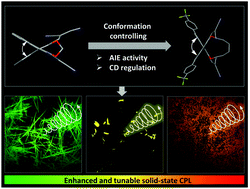Regulation of circular dichroism behavior and construction of tunable solid-state circularly polarized luminescence based on BINOL derivatives†
Abstract
The development of chiral fluorescent materials has attracted great interest. [1,1′-binaphthalene]-2,2′-diol (BINOL), a privileged C2-symmetric molecular skeleton, is one of the most frequently used chiral optical backbones. However, a phenomenon of circular dichroism (CD) annihilation in the aggregated state was observed in BINOL based molecules, which limits the application of CD in the condensed state. In this work, by inserting various bridged alkyl chains into the hydroxyl groups of 3,3′-dicyanomethylene functionalized (R)-BINOL, a series of chiral luminogens (BINB-n, n = 1 to 8) was obtained. All BINB-n luminogens exhibited aggregation-induced emission (AIE) characteristics and their molecular conformation was significantly dependent on the length of the alkyl chain, which further regulated their CD behavior from annihilation to preservation in the aggregated state. Moreover, in virtue of the AIE characteristic of BINB-6, judiciously introducing suitable electron donors successfully realized enhanced and tunable solid-state circularly polarized luminescence with the maximum glum value of 1 × 10−2.

- This article is part of the themed collections: 20th Anniversary of Aggregation-Induced Emission and Recent Progress on Aggregation-Induced Emission


 Please wait while we load your content...
Please wait while we load your content...